LG Electronics USA V496 Multi-band WCDMA/LTE Tablet with WLAN and Bluetooth User Manual 2
LG Electronics MobileComm USA, Inc. Multi-band WCDMA/LTE Tablet with WLAN and Bluetooth Users Manual 2
Contents
- 1. Users Manual 1
- 2. Users Manual 2
Users Manual 2

71
nNOTE
XWhen adding the TV remote control, QuickRemote can use the INPUT button to
configure appropriate remote control. When configuring the INPUT button, the TV
input source can be changed. To reset the TV input source, tap the INPUT button
on QuickRemote several times (depending on the number of devices connected to
the TV).
QuickRemote options
To access the QuickRemote options menu, tap the Menu icon to select the desired
option.
nNOTE
XWhile playing music in the background, pressing any QuickRemote button will mute
the sound for a second.
Clock
Setting your alarm
1 From the Home screen, tap Apps > Apps tab > Clock > .
2 Set the desired alarm time.
3 Set Repeat, Snooze duration, Vibration, Alarm sound, Alarm volume, Auto
app starter, Puzzle lock and Memo.
4 Touch Save.
nNOTE
XTo change alarm settings in the alarm list screen, touch the Menu icon and
select Settings.
Tools
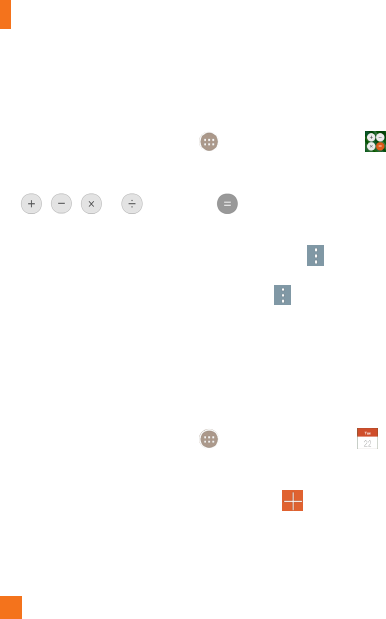
72
Calculator
Using your calculator
1 From the Home screen, tap Apps > Apps tab > Calculator .
2 Tap the number keys to enter numbers.
3 For simple calculations, tap the function you want to perform
( , , or ) followed by .
nNOTE
XFor more complex calculations, touch the Menu icon , select Scientific
calculator, then choose the desired function.
XTo view the calculation history, tap Menu icon > Calculation history.
Calendar
Events from each account you’ve added to your tablet and configured to synchronize
calendars is displayed in your Calendar.
Adding an event to your calendar
1 From the Home screen, tap Apps > Apps tab > Calendar .
2 Tap the menu at the top left corner to change the calendar view (Day, Week, Month,
Year, Agenda).
3 Tap the date you wish to add an event to and tap .
4 Touch the Event name field and enter the event name.
5 Touch the Location field and enter the location. Check the date and enter the time
you wish your event to start and finish.
Tools

73
6 If you wish to add a note to your event, touch the Description field and enter the
details.
7 Enter any other desired information.
8 Touch Save to save the event in the calendar.
nNOTE
XTouch and hold a spot on the calendar to quickly save a calendar event on that date.
Simply enter the event name and time, then tap Save. You can tap Details and
enter more information, or update the event with additional details later.
To change your calendar view
No matter where you’re in the Calendar app, you can easily switch calendar views.
Simply tap in the upper left corner of the title bar, or on the left side of the screen
swipe your finger from left to right to display a menu of calendar views. Tap Day,
Week, Month, Year, or Agenda.
Tasks
The Tasks app can be synchronized with your MS Exchange account. You can create
and manage your tasks using your tablet or from MS Outlook or MS Office Outlook Web
Access.
1 From the Home screen, tap Apps > Tasks .
2 Tap the Add task icon (in the upper-right corner of the screen).
3 Enter the Subject, START DATE, DUE DATE, DESCRIPTION, REPEAT and
REMINDER as necessary.
4 Tap Save.
Tools
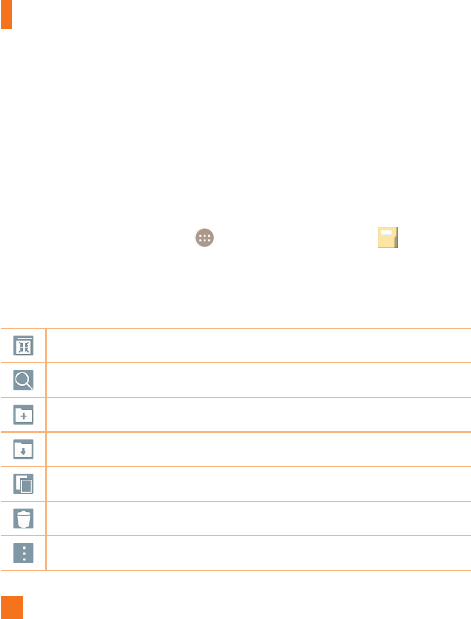
74
File Manager
The File Manager application allows you to manage files in your internal/external
storage.
File Manager makes it easy to view and manage your files. Simply tap a file type (All
files, Music files, Image files, Video files, Document files), then tap on the necessary
folders to find your files.
To open the File Manager application
• From the Home screen, tap Apps > Apps tab > File Manager .
File Manager Options
Open the File Manager app > All files > Internal storage to access to the following
options (at the top of the screen):
Allows you to open File Manager in a QSlide window.
Allows you to search for your files or information.
Allows you to create a new folder.
Allows you to move files and folders to another location.
Allows you to copy files and folders to another location.
Allows you to delete files and folders.
Allows you to access more options.
Tools
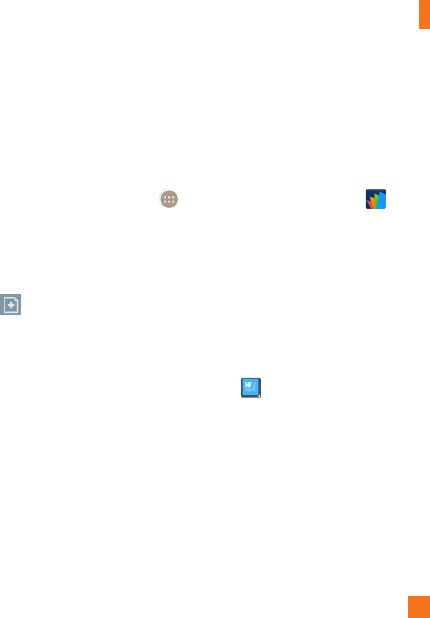
75
POLARIS Office 5
POLARIS Office 5 is a professional mobile office solution that lets users conveniently
view various types of office documents, including Word, Excel and PowerPoint files,
anywhere or anytime, using their mobile devices.
To create a new document
1 From the Home screen, tap Apps > Apps tab > POLARIS Office 5 .
2 Register your email address on the Registration page.
nNOTE
XYou can tap Skip to ignore the registration information.
3 Tap to start a new document.
4 Tap a document type from the drop-down list, then choose a template.
5 Enter contents in the document using the tools at the top of the screen and the
on-screen keyboard.
6 When you're done working on the document, tap (in the top left corner of the
screen), then tap Save (or Save as to enter a new document name) to save.
7 Enter the document name and touch Save.
To view and edit a document on your device
You can now easily view and edit a wide variety of file types, including Microsoft Office
documents and Adobe PDF, right on their mobile devices.
1 Open POLARIS Office 5 and search for a document.
2 Touch the document that you want to view or edit.
When viewing documents using POLARIS Office 5, the objects and layout remain the
same as in the original documents.
Tools

76
3 To edit the document, tap .
Google+
Use the Google+ app to stay connected with people via Google’s social network service.
From the Home screen, tap Apps > Apps tab > Google > Google+ .
nNOTE
XThis application may not be available depending on the region or service provider.
LG SmartWorld
LG SmartWorld offers an assortment of exciting content – fonts, themes, games,
applications.
How to Get to LG SmartWorld from Your Tablet
1 From the Home screen, tap Apps > Apps tab > SmartWorld to access
LG SmartWorld.
2 Select your country and tap Start LG SmartWorld.
3 Download the content you want.
• Data fees may be charged when accessing LG SmartWorld using your mobile
network.
• LG SmartWorld may not be available for all carriers or in all countries.
nNOTE: What if there is no icon?
1 Using a mobile Web browser, access LG SmartWorld (www.lgworld.com) and select
your country.
Tools

77
2 Download the LG SmartWorld app.
3 Run and install the downloaded file.
4 Access LG SmartWorld by tapping the icon.
Special benefits only in LG SmartWorld
1 LG SmartWorld allows you to personalize your tablet with customized home themes,
keyboard themes, and fonts (This service is only available to specific devices. Please
check on the LG SmartWorld website if your device is supported).
2 Take advantage of LG SmartWorld's promotions.
Tools
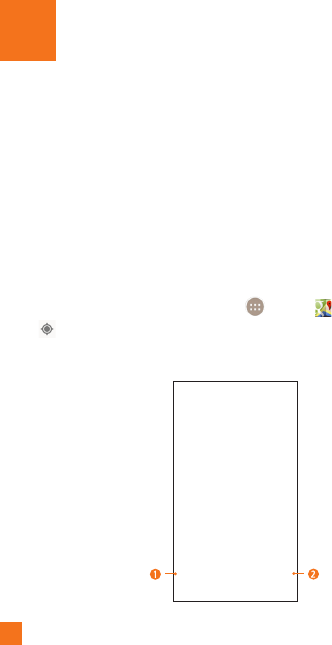
78
Google Applications
About Google applications
Google applications, including mobile versions of Gmail, Hangouts, Google Calendar,
and Google Maps, are loaded on your tablet.
1 To set up a Google account, tap any Google application, enter your user name and
password and sign in.
2 After signing in, your contacts, email, and calendar in your Google account will
automatically synchronize with your tablet.
Launch Google Maps
1 From the Home screen, tap the Apps Key >
Maps
.
2 Tap . The map centers on a blue circle that indicates your location. An arrow
indicates the direction the device is facing. A transparent blue circle around the dot
indicates that your actual location is within the circle.
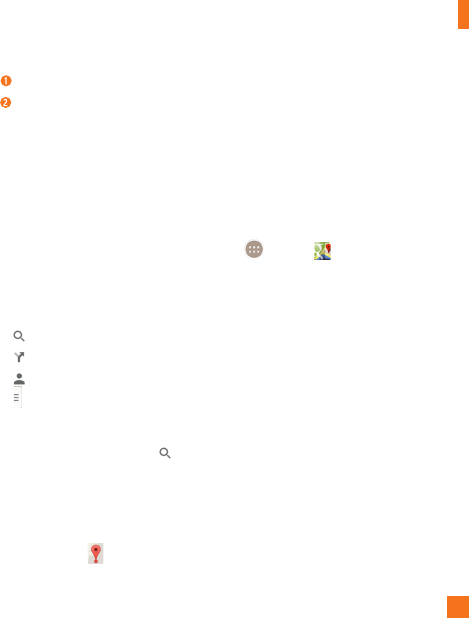
79
Google Applications
Tap to access various features on Google Maps.
Tap to view your current location.
To get an address and additional information for a location:
1 Touch and hold a location on the map. A bar with the address and a thumbnail from
Street View (if available) opens at the bottom of the screen.
2 Drag the bar upwards to access additional options.
To utilize Google Maps:
1 From the Home screen, tap the Apps Key >
Maps
.
2 Pinch out or in to zoom in or out of the current map view.
OR
Tap each icon at the top of the screen.
• (Search) to search for a location.
• (Directions) to get directions.
• (Your activity) to access your favorite places.
• (Menu) to view locations and additional information overlaid on the map.
To search for a location:
1 While viewing a map, tap .
2 In the search box, enter the place you're looking for. Red markers indicate search
matches on the map.
• You can enter an address, a city, or a type of business or establishment. For example,
“theater in New York.”
3 Tap a marker to display a bar that contains the name and travel information. Drag
the bar upwards to open a screen with more information about the location, as well

80
as options for obtaining directions.
To get directions:
1 While viewing a map, tap .
2 Enter a starting point in the Start point field, or leave as is to allow GPS to find your
location, and your destination in the End point field.
• To reverse directions, tap .
3 Tap the icon for car, public transit, biking, or walking directions.
4 The directions to your destination appear as a blue route. Select a gray route if you
prefer it.
5 Drag the bar up to view directions as text or tap to navigate to the destination.
Play Store
Play Store lets you browse through and download thousands of fun and useful
applications and games. You can check other users' comment regarding an application
or you can post your own comments. If you install applications and games from Play
Store, they appear in the tablet's menu below the preloaded applications, and you can
find them by scrolling down with your finger. You can open downloaded applications
from the Play Store by tapping >
My apps
.
nNOTE
XTo purchase a paid app, you’ll need to set up a payment method with Google
Checkout™. You have the option to use a credit card or charge to your carrier bill.
XWhen you want to exit a game or application, use the Home Key
or Back Key
, which will return you to the Home screen. Or select Menu (or Options) within
the game or application and select Exit. (Exit option may vary by game/application).
Google Applications

81
Ending applications that continue to run in the background (after going back to the
Home screen) will help conserve battery life and reduce unwanted data usage.
Gmail
Gmail can be configured when you first set up your tablet. Depending on your
synchronization settings, Gmail on your tablet is automatically synchronized with your
Gmail account on the web.The inbox conversations list is your default view.
Tap the Menu icon
for the following additional options:
Refresh, Manage labels,
Settings, Send feedback,
and
Help.
Compose
- Allows you to compose a new message.
Search
- Allows you to search your account.
Accounts & Labels
- Allows you to view your accounts and labels.
nNOTE
XDrag the screen downwards to refresh and check for new email.
Hangouts
The Hangouts application lets you have real-time text conversations with your friends.
To open the Hangouts application
From the Home screen, tap the Apps Key > Google > Hangouts .
To sign out of Hangouts
From the Hangouts home screen, tap the Menu icon > Settings > tap the desired
account > Sign out.
Google Applications
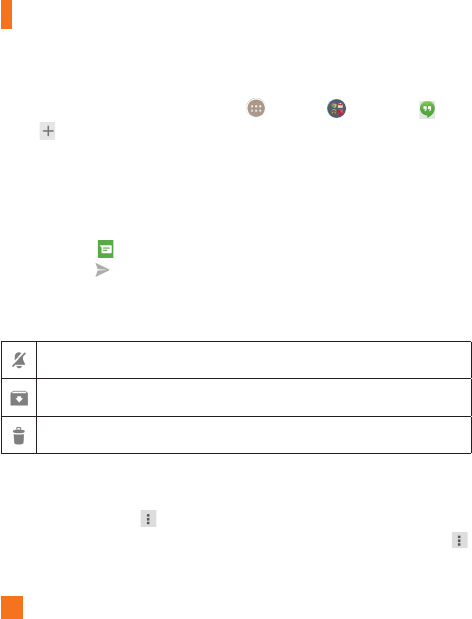
82
Chatting with Friends
1 From the Home screen, tap the Apps Key > Google > Hangouts .
2 Tap to view your contacts list. It includes all of the Google Accounts you've
added.
• Tap the name of the person in your contacts list. If your friend is not yet on Hangouts,
you can invite your friend via SMS.
OR
• Tap the text field to enter a name, email, or number.
3 Tap Message and then enter your message.
4 Tap the Send .
Hangouts chatting list
Touch and hold the friend in the chat screen. You can set below options.
Tap to turn the notifications off.
Tap to archive the conversation.
Tap to delete the conversation.
Blocking your Friends
• To block a friend from exchanging messages with you, tap the friend in the chatting
list. Tap the Menu icon
> People & options. Then tap the block option.
• To remove a friend from the blocked list, from the chatting list, tap the Menu icon
> Settings > tap the desired account > Blocked people. Then tap Unblock next to
the person’s name.
Google Applications

83
Hangouts Settings
• From the chatting list, tap the Menu icon
to choose from Set mood..., Invites,
Snooze notifications, Archived Hangouts, Settings, Send feedback, and Help.
• While chatting, tap the Menu icon to choose from People & options, New
group Hangout, Turn history off, Archive, Delete, Send feedback, and Help.
Google Applications
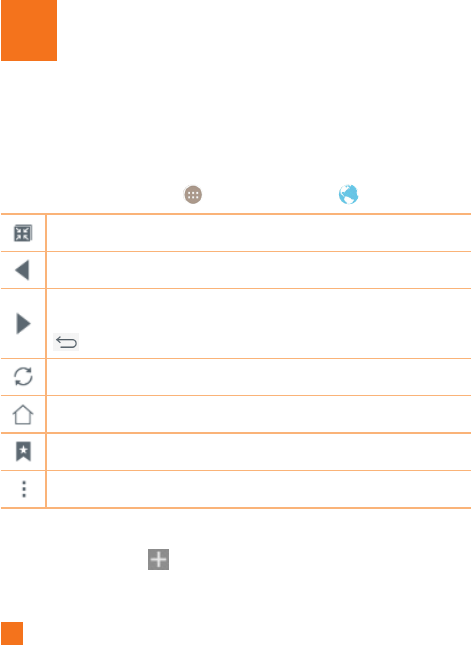
84
Browser
Use this application to browse the Internet. Browser gives you a fast, full-color world
of games, music, news, sports, entertainment and much more, right on your tablet
wherever you are and whatever you enjoy.
From the Home screen, tap Apps > Apps tab > Browser .
Tap to run QSlide.
Tap to go back one page.
Tap to go forward one page, to the page you connected to after the current
one. This is the opposite of what happens when you touch the Back Key
, which takes you to the previous page.
Tap to refresh or stop the current page.
Tap to go to the Home page.
Tap to access your bookmarks.
Touch to access more options.
Opening a page
• To open a new page, tap at the top of the browser.
• To go to another web page, tap a tab at the top of the screen to view the page.
The Web

85
Bookmarks
To open a bookmarked web page, tap on the browser toolbar and select one.
History
Tap on the browser toolbar and select the History tab to open a web page from the
list of recently-visited web pages. To clear the history, tap to clear all history.
Using Read mode
Your tablet can display simplified web pages for easier reading.
View news or blog posts and other article pages easily with no distractions – with Read
mode, you can read a clutter-free page.
Tap on the URL web address bar to activate Read mode.
Using QSlide
Use this feature to access the Internet without closing the current application.
While viewing content on the browser, tap . You can then browse other information
on your tablet. To view the browser in full screen, tap .
Download files
Use the Downloads app to see what files have been downloaded.
From the Home screen, tap Apps > Apps tab > Downloads .
Chrome
Use Chrome to search for information and browse web pages.
From the Home screen, tap Apps > Apps tab > Chrome .
The Web

86
nNOTE
XThis application may not be available, depending on your region and service
provider.
Viewing web pages
Tap the address field (at the top of the screen), enter a web address or search criteria,
and tap on the keyboard.
Opening a page
• To go to a new page, tap at the top of the browser.
• To go to another web page, tap the a tab at the top of the screen to select the page.
Searching the web by voice
Tap the address field, tap , speak a keyword and select one of the suggested
keywords that appear.
nNOTE
XThis feature may not be available depending on the region or service provider.
Syncing with other devices
Sync open tabs and bookmarks to use with Chrome on another device when you are
logged in with the same Google account.
To view open tabs on other devices, tap the Menu icon > Other devices. You must
be signed in to the same Google account on all devices. Select a web page to open.
Adding and viewing bookmarks
To add bookmarks, tap in the URL bar.
To open a bookmarked web page, tap the Menu icon > Bookmarks and select the
The Web

87
desired page.
Chrome Options menu
Tap the Menu icon to access the following options.
• New tab – Tap to open a new web page tab.
• New incognito tab – Tap to open a new incognito tab.
• Bookmarks – Displays your bookmarked web pages.
• Other devices – Displays your open web pages on other devices.
• History – Displays your browsing data (web pages you've visited).
• Share... – Allows you to share the web page.
• Print... – Tap to print the web page. Choose to automatically find a printer on your
network, or manually enter one to use.
• Find in page – Allows you to search for text on the current web page.
• Add to homescreen – Allows you to add a shortcut to the current page on your
Home screen.
• Request desktop site – Checkmark to access the desktop site when you view web
pages on your tablet.
• Settings – Allows you to change the settings specific to the Chrome app.
• Help & feedback – Displays information about using the Chrome app on your tablet
and allows you to provide feedback to Chrome developers.
The Web

88
Access the Settings menu
1 From the Home screen, tap Apps > Apps tab > Settings .
OR
From the Home screen, touch and hold the Recent Apps Key > All settings.
2 Select a setting category and set the desired option.
WIRELESS NETWORKS
Airplane mode
Allows you to set Airplane mode. Activating Airplane mode disables all wireless
connections.
Wi-Fi
Wi-Fi – Turns on Wi-Fi to connect to available Wi-Fi networks.
A list of all available Wi-Fi networks will be displayed. Tap one to connect to it.
nNOTE
XTap Search to scan for available Wi-Fi networks.
Tap the Menu icon in the Wi-Fi menu to access the following options.
Connect by WPS button – Allows you to connect to a secured Wi-Fi network with a
WPS button.
Connect by WPS PIN – Allows you to connect to a secured Wi-Fi network with a
WPS PIN.
Add network – Allows you to manually enter a new Wi-Fi network.
Settings

89
Wi-Fi Direct – Allows direct connection with Wi-Fi devices without any access point.
Advanced Wi-Fi – Accesses the advanced Wi-Fi settings.
Interactive tutorial – Displays some useful tutorials for the Wi-Fi function.
nTIP! How to obtain the MAC address
XTo set up a connection in some wireless networks with MAC filters, you may
need to enter the MAC address of your tablet in the router. You can find the MAC
address in the following user interface: From the Home screen, tap Apps >
Settings > Wi-Fi > Menu icon > Advanced Wi-Fi > MAC address.
Bluetooth
Turn the Bluetooth wireless feature on or off to use Bluetooth. Turning Bluetooth on
allows you to pair and connect to other Bluetooth devices.
Tap the Menu icon in the Bluetooth menu to access the following options.
Edit tablet name – Changes your tablet name for easy identification when pairing and
connecting. Enter your new tablet name, then tap Save.
Visibility timeout – Sets the amount of time other Bluetooth devices can see your
tablet for pairing and connection. Choose from 2 min, 5 min, 1 h, and Never time out.
Show received files – Displays a list of your Bluetooth received files.
Interactive tutorial – Displays some useful tutorials about Bluetooth features.
Help – Displays help information about the Bluetooth feature.
Data Manager
Displays the data usage during the chosen periods of time. Tap an app from the list to
view the app's data usage.
Settings

90
Share & connect
Allows you to configure various options for sharing data and connecting with other
devices.
SmartShare Beam - Allows you to receive multimedia content from LG phones or
tablets.
nNOTE
XYou must enable Wi-Fi to activate SmartShare Beam.
Media Server - Share media content with nearby devices via DLNA.
Miracast - You can mirror your tablet screen and sound onto LG Miracast dongle or TV
wirelessly.
nNOTE
XTo start the Miracast feature quickly, tap the Miracast icon in the Notification Panel.
While mirroring, Mobile Hotspot cannot be used simultaneously.
LG PC Suite - Allows you to use LG PC Suite to transfer music and images between a
computer and your tablet.
More...
Allows you to set additional wireless and networks settings.
Mobile networks – Allows you to set whether to enable or disable data access on
your tablet.
VPN – Displays the list of Virtual Private Networks (VPNs) that you've previously
configured. Allows you to add different types of VPNs.
nNOTE
XYou must enter the password before you can use credential storage.
Settings

91
DEVICE
Sound
Sound profile – Allows you to set the sound profile to Sound, Vibrate only or Silent.
Volumes – Manage the volume for Notifications sound, Touch feedback &
system, and Music, video, games & other media.
Default notification sound – Allows you to set your default notification ringtone.
Touch sounds – Allows you to set your tablet to play a sound when you touch buttons,
icons and other onscreen items that react to your touch.
Screen lock sound – Allows you to set your tablet to play a sound when locking and
unlocking the screen.
Vibrate on tap – Allows you to set the vibration feedback when the tablet screen is
touched.
Display
Home screen
Theme – Sets the screen theme for your device.
Wallpaper – Sets the wallpaper to use on your Home screen.
Screen swipe effect – Sets the effect when you swipe to change screens.
Allow Home screen looping – Checkmark to set the Home screens to scroll
continuously, eliminating the need to scroll back in the opposite direction when you
reach one end.
Home backup & restore – Allows you to backup and restore app and widget
configurations and themes.
Lock screen
Select screen lock – Set a screen lock type to secure your tablet.
Settings

92
Screen swipe effect – Sets the screen swipe effect options.
Wallpaper – Sets your Lock screen wallpaper. Select it from Gallery or Wallpaper
gallery.
Widgets – Allows you to display widgets on the Lock screen.
Shortcuts – Allows you to change the shortcuts on the Swipe Lock screen.
Owner info – Allows you to enter contact info to be displayed on the Lock screen in
case the tablet is lost.
Lock timer – Sets the amount of time before the screen automatically locks after
the screen has timed-out.
Power button instantly locks – Checkmark to instantly lock the screen when the
Power/Lock Key is pressed. This setting overrides the Security lock timer setting.
Brightness – Adjust the screen brightness. Touch Night brightness to set the
brightness to 0% automatically between the hours of 12:00 am - 6:00 am.
Screen timeout – Set the time delay before the screen automatically turns off.
Screen-off effect – Sets the screen-off effect used when the screen turns off.
Auto-rotate screen – Set to switch orientation automatically when you rotate the
tablet.
Daydream – Tap the Daydream switch to toggle it On or Off. On allows the set
screen saver to be displayed when the tablet is sleeping while docked and/or charging.
Choose from Clock and Google Photos.
nNOTE
XCharging might be slow while the screen saver is on.
Font type – Change the type of display font.
Font size – Change the size of the display font.
Smart screen – Keeps the screen on when the device detects your eyes looking at the
Settings

93
screen.
Home touch buttons – Allows you to set which Home touch buttons are displayed and
their position on the bar. You can also select the color and the background.
Motion sensor calibration – Allows you to improve the accuracy of the tilt and speed
of the sensor.
Storage
INTERNAL STORAGE – Displays the total amount of space in the device’s memory
and lists what type of data is using up space.
SD CARD – Displays the total amount of memory space on the microSD card.
Mount/Unmount SD card – Mounts and unmounts the microSD card from your
tablet so that you can access the data stored in it, format the card, or safely remove
it. This setting is dimmed if there’s no microSD card installed, if you’ve already
unmounted it, or if you’ve mounted the microSD card on your computer.
Erase SD card – Permanently erases everything on the microSD card and prepares
it for use with your tablet.
Battery
BATTERY INFORMATION – See how much battery power is used for device activities.
The battery level displays in a percentage. The remaining time of use is also displayed.
Battery percentage on status bar – Displays the battery percentage on the Status
Bar.
Battery saver – Manage the battery for the power saving items. Tap the switch
to turn this feature on. Tap Battery saver for the following options.
• Turn Battery saver on: Set the battery level at which you want Battery saver to turn
on.
• Auto-sync: Turns off Auto-sync.
Settings

94
• Wi-Fi: Turns off Wi-Fi if data is not in use.
• Bluetooth: Turns off Bluetooth if not connected.
• Vibrate on tap: Turns off touch feedback.
• Brightness: Adjusts the brightness.
• Screen timeout: Adjusts the screen timeout.
Help – Touch to access some tips for Power saver.
Smart cleaning
You can manage the unused apps, saved files or temporary internet files.
Apps
Display the list of applications such as currently running or downloaded.
Swipe left and right to view one of the three tabs across the top of the screen to
view detailed information for DOWNLOADED, ON SD CARD, RUNNING, and ALL
applications.
Tap an entry to view more information, tap Force stop (or Stop), then OK to stop it
from running.
Dual window
Split view – Allows the device to automatically open Dual window when you tap a link
on the full screen or tap an e-mail attachment (images only).
Help – Displays help information about using the Dual window feature.
Settings

95
PERSONAL
Accounts & sync
Permits applications to synchronize data in the background, whether or not you are
actively working in them. Deactivating Auto-sync data can save battery power and
lower (but not eliminate) data usage.
Users
This menu displays the current users you've created.
Add user – Allows you to add new account for the tablet and use the Multi-user
feature.
Location
Mode
• High accuracy (GPS and networks) – Use GPS and Wi-Fi networks to estimate
location.
• Battery saving (Networks only) – Use Wi-Fi networks to estimate location.
• Device sensors only (GPS only) – Use GPS to pinpoint your location.
RECENT LOCATION REQUESTS – Displays apps that have recently requested your
location information.
Camera – Allows the device to tag photos and videos with their locations.
Google Location Reporting – Allows you to view your Google location settings.
Security
Lock screen – Allows you to set your lock screen settings.
Encrypt tablet – Allows you to encrypt data on the tablet for security. You will be
required to enter a PIN or password to decrypt your tablet each time you power it on.
Settings

96
Encrypt SD card storage – Allows you to encrypt data on the MicroSD for security.
Set up SIM card lock – Allows you to set if you want to require a PIN to use or, if set,
allows you to change the PIN.
Password typing visible – Shows the last character of the hidden password as you
type.
Tablet administrators – View or deactivate tablet administrators.
Unknown sources – Allows installation of apps from non-Play Store applications.
Verify apps – Disallow or warn before installation of apps that may cause harm.
Notification access – Allows to get notifications to read all notifications posted by
the system or and installed apps.
Storage type – Displays the storage type for certificates.
Trusted credentials – Displays trusted CA certificates.
Install from storage – Choose to install encrypted certificates.
Clear credentials – Remove all certificates.
Language & input
Use the Language & input settings to select the language for the text on your tablet and
to configure the on-screen keyboard, including words you've added to its dictionary.
Backup & reset
Back up my data – Set to backup your settings and application data to the Google
server.
Backup account – Set the account to which you want to backup data to.
Automatic restore – Set to restore your settings and application data when the
applications are reinstalled on your device.
Settings

97
LG Backup service – Backs up all information on the device and restores it in the
event of data loss or replacement. Refer to page 101 for more information.
Factory data reset – Reset your settings to the factory default values and delete
all your data. If you reset the tablet this way, you are prompted to re-enter the same
information as when you first started Android.
Browser Bar
The Browser Bar at the bottom of the Browser enhances your mobile browsing
experience with contextual recommendations, social networking applications and
browser utilities. We've included some buttons to get you started and have made it
easy to add more buttons, move or remove them. To display the Browser Bar, touch and
drag the tab upwards.
nTIP
XYou must enable the Toolbar and Active Browsers options to activate the
Browser Bar.
SYSTEM
Shortcut Key
Allows you to turn the Shortcut keys on and off. Press and hold the Volume Up and
Down keys together when the screen is unlocked to access QuickMemo+. Press and
hold the Volume Up or Down key when the screen is off or locked to access the camera.
Date & time
Use Date & time settings to set how dates will be displayed. You can also use these
settings to set your own time and time zone rather than obtaining the current time from
the mobile network.
Settings

98
Accessibility
Use the Accessibility settings to configure accessibility plug-ins you have installed on
your tablet.
nNOTE
XRequires additional plug-ins to become selectable.
TalkBack – Allows you to set up the TalkBack function which assists people with
impaired vision by providing verbal feedback. Tap the TalkBack switch at the
top right corner of the screen to turn it on. Tap Settings at the bottom of the screen to
adjust the TalkBack settings.
Font size – Allows you to change the size of the text.
Invert colors – Checkmark to invert the colors of the screen and content.
Color adjustment – Sets to view the screen with greater color contrast. Tap the switch
to turn it on. Then tap the screen and drag across the screen in any direction
until you see the color contrast you want to use.
Touch zoom – Allows you to zoom in and out by triple-tapping the screen.
Screen shades – Dims the screen's backlight.
Accessibility shortcut – Activate this feature to allow you to quickly enable
accessibility features in two steps.
Text-to-speech output – Sets the text-to-speech preferred engine and speech rate
setting. Also plays a short demonstration of speech synthesis. The default language
status is also displayed.
Audio type – Sets the audio type. Choose Mono or Stereo.
Sound balance – Sets the audio route. Move the slider on the slide bar to set it.
Turn off all sounds – Turns off all sounds.
Settings
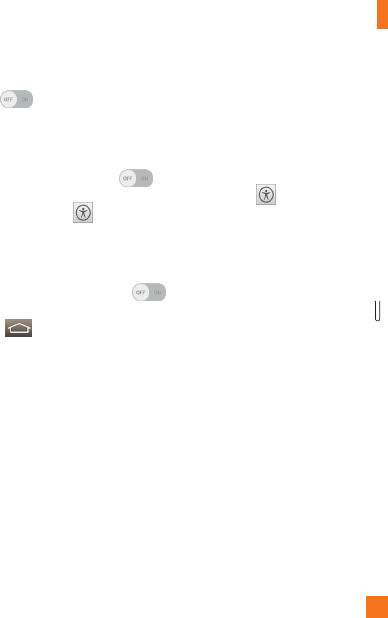
99
Captions – Allows to customize caption settings for those with hearing impairments.
Tap the switch to turn this feature on. Set the language, text size, and caption
style options as desired.
Touch feedback time – Sets the touch and feedback time. Choose from Short,
Medium, and Long.
Touch assistant – Touch the switch to toggle between on and off. On allows
you to replace the hardware keys with a Universal touch board .
Tap the Universal touch icon to access the Power, Home, Volume down,
Volume up, Screen capture, Accessibility, and Pinch buttons. Draw a "W" on the
board to automatically launch the browser application.
Screen timeout – Sets the amount of time before the screen turns off.
Touch control areas – Tap the switch to turn this feature on. Allows you to
limit the touch control to selected areas of the screen. Press the Volume Down Key
and Home Key at the same time to activate and deactivate the feature.
Auto-rotate screen – Checkmark to allow the device to rotate the screen depending
on the device orientation (portrait or landscape).
Password voice confirmation – Checkmark to have verbal confirmation when
inputting passwords.
Accessibility settings shortcut – Sets quick and easy access to selected features
when you triple-tap the Home Key.
One-touch input – Each finger touch enters a letter/character on the LG keyboard.
Quick Cover
Activate this menu to turn the screen on or off automatically when using the Quick
Cover.
Settings

100
Printing
Allows you to print the content of certain screens (such as web pages displayed in
Chrome) to a printer connected to the same Wi-Fi network as your Android device.
About tablet
This menu allows you to manage your software updates and view various information
relating to your tablet.
Tablet name – Allows you to set your tablet name.
Software Update – Allows you to check for software updates.
Network – Allows you to see the network, signal strength, mobile network type and
state, service state, roaming state, and IP address.
Status – Allows you to view the phone number, IMEI, and IMEI SV.
Battery – Allows you to view battery status, battery level, and battery use information.
Hardware information – Allows you to view the model number, up time, Wi-Fi MAC
address and Bluetooth address.
Software information – Allows you to view Android version, baseband version, kernel
version, build number, and software version.
Legal information – Allows you to view legal documents for LG software, open source
licenses and Google legal information.
Patent information – Displays LG patent information.
Settings

101
About backing up and restoring device data
It is recommended that you regularly create and save a backup file on the internal
storage, especially before updating any software. Maintaining a current backup file in
storage memory may allow you to recover device data if your device is lost, stolen, or
corrupted by an unforeseen issue.
This LG Backup application is supported between LG smartphones and tablets,
other software or operating system versions. As a result, when you buy the new LG
smartphones and tablets, you can backup the current device data to your new device.
If you have the LG Backup application preloaded on your smartphones and tablets,
you can backup and restore most of your data, including downloaded and pre-installed
applications, bookmarks, calendar entries, contacts, home screen settings, and system
settings. You may also:
• Perform a manual backup of your device.
• Schedule automatic backups of your device.
• Restore your device data.
nWarning!
XTo protect against an unexpected power off during backup or restore operations,
due to insufficient battery power, you should always keep your battery fully charged.
Backup your tablet data
1 From the Home screen, tap Apps > Settings > Backup & reset > LG
Backup service > Backup.
2 On the Backup Location screen, touch Internal storage or SD card, then tap Next.
3 Select the check box for the items you want to backup and select Next.
LG Backup

102
4 Read the information presented on the screen, then tap Start.
5 When all selected files have been backed up, you will see the message Back up
completed.
Scheduling automatic backups
You can also program automatic backups for the data on your tablet according to your
schedule setting. To do this, complete the following steps:
1 From the Home screen, tap Apps > Settings > Backup & reset > LG
Backup service > Scheduled backup.
2 Tap Backup items and select the check box next to the item you want to backup.
3 Tap Backup location, and select Internal storage or SD card.
4 Set the backup time and scheduled backup files.
5 Tap the switch to activate automatic backups.
Restoring tablet data
nNOTE
XAll files that are stored on your tablet are deleted before the backup file is restored.
Make sure to copy the backup file to another location.
1 From the Home screen, tap Apps > Settings > Backup & reset > LG
Backup service > File restore & management.
2 On the Restore screen, select a backup file that contains the data you wish to
restore.
3 Select the check box next to the item you wish to restore and select Start to restore
it to your tablet.
LG Backup

103
nNOTE
XPlease note that your tablet data will be overwritten with the content of your
backup.
4 If the backup file is encrypted, type the password that you created to encrypt it.
5 When all selected files have been restored, the tablet will automatically be restart.
nNOTE
XYou can set the Lock backup files option when creating a backup to encrypt your
backup files for extra protection.
On the LG Backup main screen, touch the Menu icon > Set password and enter a
password and hint in case you forgot your password. Once you have set up a password,
you need to enter it every time you want to do backup/restore.
LG Backup

104
Tablet software update
This feature allows you to update the firmware of your tablet to the latest version
conveniently from the internet without the need to visit a service center. For more
information on how to use this function, please visit: http://www.lg.com
As the tablet firmware update requires the user’s full attention for the duration of the
update process, please make sure to check all instructions and notes that appear at
each step before proceeding. Please note that removing the USB cable or battery during
the upgrade may seriously damage your tablet.
LG tablet software update via Over-the-Air (OTA)
This feature allows you to update the firmware of your tablet to the newer version
conveniently via OTA without connecting the USB data cable. This feature is only
available if and when LG makes the newer version of the firmware available for your
device. First, you can check the software version on your tablet:
From the Home screen, tap Apps > Settings > About tablet > Software
information.
To perform the tablet software update, from the Home screen, tap Apps >
Settings > About tablet > Software Update > Update now.
nNOTE
XLG reserves the right to make firmware updates available only for selected models
at its own discretion and does not guarantee the availability of the newer version of
the firmware for all tablet models.
Tablet software update

105
XYour personal data—including information about your Google account and any
other accounts, your system/application data and settings, any downloaded
applications and your DRM licence —might be lost in the process of updating your
device's software. Therefore, LG recommends that you back up your personal data
before updating your tablet's software. LG does not take responsibility for any loss
of personal data.
Tablet software update

106
There are a variety of accessories available for your tablet, some of which may be sold
separately. You can select these options according to your personal communication
requirements.
NOTE
XAlways use genuine LG accessories. Failure to do this may invalidate your warranty.
XAccessories may be different in different regions; please check with our regional
service company or agent for further enquiries.
Accessories
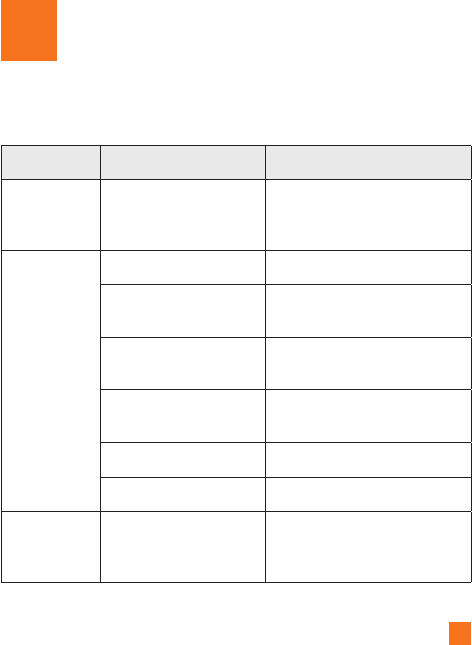
107
This chapter lists some problems you might encounter when using your tablet. Some
problems require you to call your service provider, but most are easy to fix yourself.
Message Possible causes Possible corrective measures
No
applications
can be set
Not supported by service
provider or registration
required.
Contact your service provider.
Charging error
Battery is not charged. Charge battery.
Outside temperature is too
hot or cold.
Make sure tablet is charging at a
normal temperature.
Contact problem Check the charger and its
connection to the tablet.
No voltage Plug the charger into a different
socket.
Charger defective Replace the charger.
Wrong charger Use only original LG accessories.
Impossible to
receive / send
photos
Memory full Delete some images from your
tablet.
Troubleshooting

108
Message Possible causes Possible corrective measures
Files do not
open Unsupported file format Check the supported file formats.
No sound Vibration mode
Check the settings status in the
sound menu to make sure you are
not in vibration or silent mode.
Troubleshooting

109
Violation of the instructions may cause serious injury or death.
WARNING: This product contains chemicals known to the State of California to cause
cancer and birth defects or reproductive harm.
Wash hands after handling.
ELECTRICAL SAFETY
This product is intended for use when supplied with power from the designated battery
or power supply unit. Other usage may be dangerous and will invalidate any approval
given to this product.
SAFETY PRECAUTIONS FOR PROPER GROUNDING INSTALLATION
CAUTION: Connecting to improperly grounded equipment can result in an electric
shock to your device. This product is equipped with a USB cable for connecting to a
desktop or notebook computer. Be sure your computer is properly grounded (earthed)
before connecting this product to the computer. The power supply cord of a desktop
or notebook computer has an equipment-grounding conductor and a grounding plug.
The plug must be plugged into an appropriate outlet which is properly installed and
grounded in accordance with all local codes and ordinances.
SAFETY PRECAUTIONS FOR POWER SUPPLY UNIT
Use the correct external power source
A product should be operated only from the type of power source indicated on the
electrical ratings label. If you are not sure of the type of power source required, consult
your authorized service provider or local power company. For a product that operates
from battery power or other sources, refer to the operating instructions that are included
with the product.
For Your Safety

110
For Your Safety
• Never place your tablet in a microwave oven as it will cause the battery
to explode.
• Never store your tablet in temperatures less than -4°F or greater than
122°F.
• When riding in a car, do not leave your tablet or set up the hands-free
kit near the air bag. If wireless equipment is improperly installed and the
air bag is deployed, you may be seriously injured.
• Your tablet contains an internal battery. Do not dispose of your tablet
near fire or with hazardous or flammable waste. You should dispose of
your tablet in accordance with all applicable laws.
• Do not use the tablet in areas where its use is prohibited. (For example:
aircraft)
• Do not expose the battery charger or adapter to direct sunlight or use it
in places with high humidity, such as a bathroom.
• Do not use harsh chemicals (such as alcohol, benzene, thinners, etc.) or
detergents to clean your tablet. This could cause a fire.
• Do not drop, strike, or shake your tablet severely. It may harm the
internal circuit boards of the tablet.
• Do not use your tablet in high explosive areas as the tablet may
generate sparks.
• Do not damage the power cord by bending, twisting, pulling, or heating.
Do not use the plug if it is loose as it may cause electric shock or fire.

111
For Your Safety
• Do not place any heavy items on the power cord. Do not allow the
power cord to be crimped as it may cause electric shock or fire.
• Do not handle the tablet with wet hands while it is being charged. It
may cause an electric shock or seriously damage your tablet.
• Do not disassemble the tablet.
• Do not attempt to repair or modify the device yourself. Your device
is equipped with an internal rechargeable battery which should be
replaced only by LG or an authorized LG repair center.
• You should never attempt to open or disassemble this device yourself
and doing so may cause damage that voids your warranty.
• Make sure that no sharp-edged items, such as animal’s teeth or nails,
come into contact with the battery. This could cause a fire.
• Be careful that children do not swallow any parts (such as earphone,
connection parts of the tablet, etc.) This could cause asphyxiation or
suffocation resulting in serious injury or death.
• Unplug the power cord and charger during lightning storms to avoid
electric shock or fire.
• Only use chargers provided by LG. The warranty will not be applied to
products provided by other suppliers.
• Only authorized personnel should service the tablet and its accessories.
Faulty installation or service may result in accidents and consequently
invalidate the warranty.

112
For Your Safety
• Your tablet is an electronic device that generates heat during normal
operation. Extremely prolonged, direct skin contact in the absence of
adequate ventilation may result in discomfort or minor burns. Therefore,
use care when handling your tablet during or immediately after
operation.
Safety Information
Please read and observe the following information for safe and proper use of your tablet
and to prevent damage.
• Do not disassemble or open crush, bend or deform, puncture or shred.
• Repairs under warranty, at LG’s option, may include replacement parts or boards that
are either new or reconditioned, provided that they have functionality equal to that of
the parts being replaced.
• Do not modify or remanufacture, attempt to insert foreign objects into the battery,
immerse or expose to water or other liquids, expose to fire, explosion or other hazard.
• Only use the battery for the system for which it is specified.
• Only use the battery with a charging system that has been qualified with the system
per CTIA Certification Requirements for Battery System Compliance to IEEE1725. Use
of an unqualified battery or charger may present a risk of fire, explosion, leakage, or
other hazard.
• Do not short circuit a battery or allow metallic conductive objects to contact battery
terminals.
• Replace the battery only with another battery that has been qualified with the system
per this standard, IEEE-Std-1725. Use of an unqualified battery may present a risk of
fire, explosion, leakage or other hazard. Only authorized service providers shall replace
battery (If the battery is non-user replaceable)

113
For Your Safety
• Promptly dispose of used batteries in accordance with local regulations.
• Avoid dropping the tablet. If the tablet is dropped, especially on a hard surface, and
the user suspects damage, take it to a service center for inspection.
• Improper battery use may result in a fire, explosion or other hazard.
• For those host devices that utilize a USB port as a charging source, the host device’s
user manual shall include a statement that the device shall only be connected to
products that bear the USB-IF logo or have completed the USB-IF compliance program.
nWARNING! Notice for Battery replacement
• For your safety, do not remove the battery incorporated in the product. If you need to
replace the battery, take it to the nearest authorized LG Electronics service point or
dealer for assistance.
• Li-Ion Battery is a hazardous component which can cause injury.
• Battery replacement by non-qualified professional can cause damage to your device.
Charger and Adapter Safety
• The charger and adapter are intended for indoor use only.
• Insert the battery pack charger vertically into the wall power socket.
• Unplug the power cord and charger during lightning storms to avoid electric shock or
fire.
• Use the correct adapter for your tablet when using the battery pack charger abroad.
Battery Information and Care
• Please read the manual of proper installation and removal of the battery.
• Please read the manual of specified charger about charging method.
• Do not damage the power cord by bending, twisting, or heating. Do not use the plug if

114
For Your Safety
it is loose as it may cause electric shock or fire.
Do not place any heavy items on the power cord. Do not allow the power cord to be
crimped as it may cause electric shock or fire.
• Unplug the power cord prior to cleaning your tablet, and clean the power plug pin
when it’s dirty. When using the power plug, ensure that it’s firmly connected. If not,
it may cause excessive heat or fire. If you put your tablet in a pocket or bag without
covering the receptacle of the tablet (power plug pin), metallic articles (such as a
coin, paperclip or pen) may short-circuit the tablet. Short-circuit of the terminal may
damage the battery and cause an explosion. Always cover the receptacle when not
in use.
• Recharge the battery after long periods of non-use to maximize battery life. Battery
life will vary due to usage pattern and environmental conditions.
• Never store your tablet in temperature less than -4 °F or greater than 122 °F.
• Charging temperature range is between 0°C/32°F and 45°C/113°F. Do not charge the
battery out of recommended temperature range. Charging out of recommended range
might cause the generating heat or serious damage of battery. And also, it might
cause the deterioration of battery’s characteristics and cycle life.
• Do not use or leave the device under the blazing sun or in heated car by sunshine. The
device may generate heat, smoke or flame. And also, it might cause the deterioration
of battery’s characteristics or cycle life.
• The battery back in the device has protection circuit to avoid the danger. Do not use
near places that can generate static electricity more than 100 V which could damage
the protection circuit. Damaged protection circuits may generate smoke, rupture or
ignite.
• When using the device for the first time, if it emits a bad smell, you see rust on it, or
anything else abnormal, do not use the equipment and bring the battery to the shop
which it was bought.

115
For Your Safety
• Keep device away from babies and small children. If children use the battery, their
parents or legal guardians are responsible for supervising and teaching them about
the safe handling of device and how to use batteries according to the manual with
care.
• If liquid from the battery in the device rubs against skin or clothing, wash with fresh
water. It may cause the skin inflammation. Do not user the battery and take it to the
nearest authorized LG Electronics service point or dealer for assistance. Be careful
that children do not swallow any parts (such as earphone, connection parts of the
device, etc.). This could cause asphyxiation or suffocation resulting in serious injury
or death.
• Do not handle the tablet with wet hands while it is being charged. It may cause an
electric shock or seriously damage your tablet.
• Do not use harsh chemicals (such as alcohol, benzene, thinners, etc.) or detergents to
clean your tablet. This could cause a fire.
• Always unplug the charger from the wall socket after the tablet is fully charged to
save unnecessary power consumption of the charger.
Care and Maintenance
Your mobile device is a product of superior design and craftsmanship and should be
treated with care. The suggestions below will help you fulfill any warranty obligations
and allow you to enjoy this product for many years:
Keep your Mobile Device away from: Liquids of any kind
Keep the mobile device dry. Precipitation, humidity, and liquids contain minerals that
will corrode electronic circuits. If the mobile device does get wet, do not accelerate
drying with the use of an oven, microwave, or dryer, because this may damage the

116
For Your Safety
mobile device and could cause a fire or explosion.
Do not use the mobile device with a wet hand.
Doing so may cause an electric shock to you or damage to the mobile device.
Extreme heat or cold
• Avoid temperatures below 0 °C / 32 °F or above 45 °C / 113 °F.
• Use your tablet in temperatures between 0 ºC /32 °F and 40 ºC/104 °F, if possible.
Exposing your tablet to extremely low or high temperatures may result in damage,
malfunction, or even explosion.
Microwaves
Do not try to dry your mobile device in a microwave oven. Doing so may cause a fire or
explosion.
Dust and dirt
Do not expose your mobile device to dust, dirt, or sand.
Sunscreen lotion
Do not expose or wear your device to any liquid like sunscreen lotion.
Doing so may cause your device to or damage to the mobile device.
Cleaning solutions
Do not use harsh chemicals, cleaning solvents, or strong detergents to clean the mobile
device.
Wipe it with a soft cloths lightly dampened in a mild soap-and-water solution.

117
For Your Safety
Shock or vibration
Do not drop, knock, or shake the mobile device.
Rough handling can break internal circuit boards.
Paint
Do not paint the mobile device. Paint can clog the device’s moving parts or ventilation
openings and prevent proper operation.
General Notice
• Do not place items containing magnetic components such as a credit card, phone
card, bank book, or subway ticket near your device. The magnetism of the device may
damage the data stored in the magnetic strip.
• When the tablet is not used for a long period time, store it in a safe place with the
power cord unplugged.
• Do not use the device if the antenna is damaged. If a damaged antenna contacts skin,
it may cause a slight burn. Please contact an LG Authorized Service Center to replace
the damaged antenna.
• The data saved in your tablet might be deleted due to careless use, repair of the
tablet, or upgrade of the software. Please backup your important contacts. (pictures,
and videos could also be deleted.) The manufacturer is not liable for damage due to
the loss of data.
• When you use the tablet in public places, set the volume to vibration so you don’t
disturb others.
• Do not turn your tablet on or off when putting it to your ear.
• Your device is an electronic device that generates heat during normal operation.
Extremely prolonged, direct skin contact in the absence of adequate ventilation may

118
For Your Safety
result in discomfort or minor burns. Therefore, use care when handling your device
during or immediately after operation.
• Use accessories, such as earphones and headsets, with caution. Ensure that cables
are tucked away safely and do not touch the antenna unnecessarily.
Part 15.19 statement
This device complies with part 15 of FCC rules.
Operation is subject to the following two conditions:
(1) This device may not cause harmful interference, and (2) this device must accept any
interference received, including interference that causes undesired operation.
Part 15.21 statement
Any changes or modifications not expressly approved by the manufacturer could void
the user’s authority to operate the equipment.
Part 15.105 statement
This equipment has been tested and found to comply with the limits for a class B digital
device, pursuant to Part 15 of the FCC Rules. These limits are designed to provide
reasonable protection against harmful interference in a residential installation. This
equipment generates uses and can radiate radio frequency energy and, if not installed
and used in accordance with the instructions, may cause harmful interference to radio
communications. However, there is no guarantee that interference will not occur in a
particular installation. If this equipment does cause harmful interference or television
reception, which can be determined by turning the equipment off and on, the user is
encouraged to try to correct the interference by one or more of the following measures:
• Reorient or relocate the receiving antenna.
• Increase the separation between the equipment and receiver.

119
For Your Safety
• Connect the equipment into an outlet on a circuit different from that to which the
receiver is connected.
• Consult the dealer or an experienced radio/TV technician for help.
FCC RF Exposure Information
WARNING! Read this information before operating the device.
In August 1996, the Federal Communications Commission (FCC) of the United States,
with its action in Report and Order FCC 96-326, adopted an updated safety standard
for human exposure to Radio Frequency (RF) electromagnetic energy emitted by FCC
regulated transmitters. Those guidelines are consistent with the safety standard
previously set by both U.S. and international standards bodies. The design of this device
complies with the FCC guidelines and these international standards.
Bodily Contact During Operation
This device was tested for typical use with the back of the device kept 0 inch (0 cm)
from the body.
Caution
Use only the supplied antenna. Use of unauthorized antennas (or modifications to the
antenna) could impair call quality, damage the device, void your warranty and/or violate
FCC regulations.
Don’t use the device with a damaged antenna. A damaged antenna could cause a minor
skin burn. Contact your local dealer for a replacement antenna.

120
For Your Safety
Consumer Information About Radio Frequency Emissions
Your wireless device, which contains a radio transmitter and receiver, emits radio
frequency energy during use. The following consumer information addresses commonly
asked questions about the health effects of wireless devices.
Are wireless devices safe?
Scientific research on the subject of wireless devices and radio frequency (“RF”) energy
has been conducted worldwide for many years, and continues. In the United States, the
Food and Drug Administration (“FDA”) and the Federal Communications Commission
(“FCC”) set policies and procedures for wireless devices. The FDA issued a website
publication on health issues related to device usage where it states, The scientific
community at large … believes that the weight of scientific evidence does not show
an association between exposure to radiofrequency (RF) from the devices and adverse
health outcomes. Still the scientific community does recommend conducting additional
research to address gaps in knowledge. That research is being conducted around the
world and FDA continues to monitor developments in this field. You can access the joint
FDA/FCC website at http://www.fda.gov (under “C” in the subject index, select Cell
Phones > Research). You can also contact the FDA toll-free at (888) 463-6332 or (888)
INFO-FDA. In June 2000, the FDA entered into a cooperative research and development
agreement through which additional scientific research is being conducted. The FCC
issued its own website publication stating that “there is no scientific evidence that
proves that wireless device usage can lead to cancer or a variety of other problems,
including headaches, dizziness or memory loss”.
This publication is available at http://www.fcc.gov/oet/rfsafety or through the FCC at
(888) 225-5322 or (888) CALL-FCC.

121
For Your Safety
What does “SAR” mean?
In 1996, the FCC, working with the FDA, the U.S. Environmental Protection Agency, and
other agencies, established RF exposure safety guidelines for wireless devices in the
United States. Before a wireless device model is available for sale to the public, it must
be tested by the manufacturer and certified to the FCC that it does not exceed limits
established by the FCC. One of these limits is expressed as a Specific Absorption Rate,
or “SAR”. SAR is a measure of the rate of absorption of RF energy in the body. Tests for
SAR are conducted with the device transmitting at its highest power level in all tested
frequency bands. Since 1996, the FCC has required that the SAR of handheld wireless
device not exceed 1.6 watts per kilogram, averaged over one gram of tissue.
Although the SAR is determined at the highest power level, the actual SAR value
of a wireless device while operating can be less than the reported SAR value. This
is because the SAR value may vary from call to call, depending on factors such as
proximity to a cell site, the proximity of the device to the body while in use, and the
use of hands-free devices. Before a device model is available for sale to the public, it
must be tested and certified to the FCC that it does not exceed the limit established
by the government-adopted requirement for safe exposure. The tests are performed in
positions and locations (e.g., at the ear and worn on the body) as required by the FCC
for each model.
The FCC has granted an Equipment Authorization for this model device with all reported
SAR levels evaluated as in compliance with the FCC RF emission guidelines. SAR
information on this model device is on file with the FCC and can be found under the
Display Grant section of http://www.fcc.gov/oet/ea/fccid/ after searching on FCC ID
ZNFV496.
For more information about SARs, see the FCC’s OET Bulletins 56 and 65 at http://
www.fcc.gov/Bureaus/Engineering_Technology/Documents/bulletins or visit the
Cellular Telecommunications Industry Association website at http://www.ctia.org/

122
For Your Safety
consumer_info/index.cfm/AID/10371. You may also wish to contact the manufacturer
of your device.
Can I minimize my RF exposure?
If you are concerned about RF, there are several simple steps you can take to minimize
your RF exposure. You can, of course, reduce your talk time. You can place more
distance between your body and the source of the RF, as the exposure level drops off
dramatically with distance. The FDA/FCC website states that “hands-free kits can be
used with wireless devices for convenience and comfort. These systems reduce the
absorption of RF energy in the head because the device, which is the source of the
RF emissions, will not be placed against the head. On the other hand, if the device is
mounted against the waist or other part of the body during use, then that part of the
body will absorb more RF energy. Wireless devices marketed in the U.S. are required
to meet safety requirements regardless of whether they are used against the head
or against the body. Either configuration should result in compliance with the safety
limit”. Also, if you use your wireless device while in a car, you can use a device with an
antenna on the outside of the vehicle. You should also read and follow your wireless
device manufacturer’s instructions for the safe operation of your device.
Do wireless devices pose any special risks to children?
The FDA/FCC website states that “the scientific evidence does not show a danger to
users of wireless communication devices, including children”. The FDA/FCC website
further states that “some groups sponsored by other national governments have
advised that children be discouraged from using wireless device at all”. For example,
the Stewart Report from the United Kingdom [“UK”] made such a recommendation
in December 2000. In this report a group of independent experts noted that no
evidence exists that using a device causes brain tumors or other ill effects. [The UK’s]
recommendation to limit device use by children was strictly precautionary; it was not

123
For Your Safety
based on scientific evidence that any health hazard exists. A copy of the UK’s leaflet is
available at http://www.dh.gov.uk (search “mobile”), or you can write to: NRPB, Chilton,
Didcot, Oxon OX11 ORQ, United Kingdom. Copies of the UK’s annual reports on mobile
device and RF are available online at www.iegmp.org.uk and http://www.hpa.org.uk/
radiation/ (search “mobile”). Parents who wish to reduce their children’s RF exposure
may choose to restrict their children’s wireless device use.
Where can I get further information about RF emissions?
For further information, see the following additional resources (websites current as of
April 2005):
U.S. Food and Drug Administration
FDA Consumer magazine
November-December 2000
Telephone: (888) INFO-FDA
http://www.fda.gov
(Under “C” in the subject index, select Cell Phones > Research.)
U.S. Federal Communications Commission
445 12th Street, S.W.
Washington, D.C. 20554
Telephone: (888) 225-5322
http://www.fcc.gov/oet/rfsafety
Independent Expert Group on Mobile Devices
http://www.iegmp.org.uk

124
For Your Safety
Royal Society of Canada Expert Panels on Potential Health Risks of Radio
Frequency Fields from Wireless Telecommunication Devices
283 Sparks Street
Ottawa, Ontario K1R 7X9
Canada
Telephone: (613) 991-6990
World Health Organization
Avenue Appia 20
1211 Geneva 27
Switzerland
Telephone: 011 41 22 791 21 11
http://www.who.int/mediacentre/factsheets/fs193/en/
International Commission on Non-Ionizing Radiation Protection
c/o Bundesamt fur Strahlenschutz
Ingolstaedter Landstr. 1
85764 Oberschleissheim
Germany
Telephone: 011 49 1888 333 2156
http://www.icnirp.de
Wi-Fi Caution
This device is capable of operating in 802.11a/n mode. For 802.11a/n devices operating
in the frequency range of 5.15 - 5.25 GHz, they are restricted for indoor operations to

125
For Your Safety
reduce any potential harmful interference for Mobile Satellite Services (MSS) in the US.
Wi-Fi Access Points that are capable of allowing your device to operate in 802.11a/n
mode (5.15 - 5.25 GHz band) are optimized for indoor use only.
If your Wi-Fi network is capable of operating in this mode, please restrict your Wi-Fi use
indoors to not violate federal regulations to protect Mobile Satellite Services.
Engineering in Medicine and Biology Society, Committee on Man and
Radiation (COMAR) of the Institute of Electrical and Electronics Engineers
http://ewh.ieee.org/soc/embs/comar/
Consumer Information on SAR
(Specific Absorption Rate)
This model device meets the government's requirements for exposure to radio waves.
Your wireless device is a radio transmitter and receiver. It is designed and manufactured
not to exceed the emission limits for exposure to Radio Frequency (RF) energy set by the
Federal Communications Commission of the U.S. Government. These limits are part of
comprehensive guidelines and establish permitted levels of RF energy for the general
population. The guidelines are based on standards that were developed by independent
scientific organizations through periodic and thorough evaluation of scientific studies.
The standards include a substantial safety margin designed to assure the safety of all
persons, regardless of age and health.
The exposure standard for wireless mobile devices employs a unit of measurement
known as the Specific Absorption Rate, or SAR. The SAR limit set by the FCC is 1.6 W/
kg.
Tests for SAR are conducted using standard operating positions specified by the FCC
with the device transmitting at its highest certified power level in all tested frequency

126
For Your Safety
bands. Although SAR is determined at the highest certified power level, the actual SAR
level of the device while operating can be well below the maximum value. Because the
device is designed to operate at multiple power levels to use only the power required to
reach the network, in general, the closer you are to a wireless base station antenna, the
lower the power output.
Before a device model is available for sale to the public, it must be tested and certified
to the FCC that it does not exceed the limit established by the government-adopted
requirement for safe exposure. The tests are performed in positions and locations (e.g.,
at the ear and worn on the body) as required by the FCC for each model.
The highest SAR value for this device when worn on the body, as described in this
user guide, is 0.83 W/kg. (body-worn measurements differ among device models,
depending upon available accessories and FCC requirements). While there may be
differences between SAR levels of various devices and at various positions, they all
meet the government requirement for safe exposure.
The FCC has granted an Equipment Authorization for this model device with all
reported SAR levels evaluated as in compliance with the FCC RF emission guidelines.
SAR information on this model device is on file with the FCC and can be found under
the Display Grant section of http://www.fcc.gov/oet/fccid after searching on FCC ID
ZNFV495. Additional information on Specific Absorption Rates (SAR) can be found
on the Cellular Telecommunications Industry Association (CTIA) website at http://
www. ctia.org/.
* In the United States and Canada, the SAR limit for mobile device used by the public
is 1.6 watts/kg (W/kg) averaged over one gram of tissue. The standard incorporates a
substantial margin of safety to give additional protection for the public and to account
for any variations in measurements.

127
For Your Safety
Caution: Avoid potential hearing loss.
Prolonged exposure to loud sounds (including music) is the most common cause of
preventable hearing loss. Some scientific research suggests that using portable audio
devices, such as portable music players and cellular telephones, at high volume settings
for long durations may lead to permanent noise-induced hearing loss. This includes
the use of headphones (including headsets, earbuds and Bluetooth® or other wireless
devices). Exposure to very loud sound has also been associated in some studies with
tinnitus (a ringing in the ear), hypersensitivity to sound and distorted hearing. Individual
susceptibility to noise-induced hearing loss and other potential hearing problems varies.
The amount of sound produced by a portable audio device varies depending on the
nature of the sound, the device, the device settings and the headphones. You should
follow some commonsense recommendations when using any portable audio device:
• Set the volume in a quiet environment and select the lowest volume at which you can
hear adequately.
• When using headphones, turn the volume down if you cannot hear the people
speaking near you or if the person sitting next to you can hear what you are listening
to.
• Do not turn the volume up to block out noisy surroundings. If you choose to listen to
your portable device in a noisy environment, use noise-cancelling headphones to block
out background environmental noise.
• Limit the amount of time you listen. As the volume increases, less time is required
before your hearing could be affected.
• Avoid using headphones after exposure to extremely loud noises, such as rock
concerts, that might cause temporary hearing loss. Temporary hearing loss might
cause unsafe volumes to sound normal.
• Do not listen at any volume that causes you discomfort. If you experience ringing in

128
For Your Safety
your ears, hear muffled speech or experience any temporary hearing difficulty after
listening to your portable audio device, discontinue use and consult your doctor.
You can obtain additional information on this subject from the following sources:
Safety 205
American Academy of Audiology 11730
Plaza American Drive, Suite 300
Reston, VA 20190
Voice: (800) 222-2336
Email: info@audiology.org
Internet: www.audiology.org
National Institute on Deafness and Other Communication
Disorders
National Institutes of Health
31 Center Drive, MSC 2320
Bethesda, MD USA 20892-2320
Voice: (301) 496-7243
Email: nidcdinfo@nih.gov
Internet: http://www.nidcd.nih.gov/health/hearing
National Institute for Occupational Safety and Health Hubert H. Humphrey Bldg.
200 Independence Ave., SW Washington, DC 20201 Voice:
1-800-35-NIOSH (1-800-356-4674)
Internet: http://www.cdc.gov/niosh/topics/noise/default.html

129
For Your Safety
TIA Safety Information
The following is the complete TIA Safety Information for wireless handheld devices.
Exposure to Radio Frequency Signal
Your wireless handheld portable device is a low power radio transmitter and receiver.
When ON, it receives and sends out Radio Frequency (RF) signals.
In August, 1996, the Federal Communications Commissions (FCC) adopted RF exposure
guidelines with safety levels for handheld wireless devices. Those guidelines are
consistent with the safety standards previously set by both U.S. and international
standards bodies:
ANSI C95.1 (1992) *
NCRP Report 86 (1986)
ICNIRP (1996)
* American National Standards Institute; National Council on Radiation Protection and
Measurements; International Commission on Non-Ionizing Radiation Protection
Those standards were based on comprehensive and periodic evaluations of the relevant
scientific literature. For example, over 120 scientists, engineers, and physicians from
universities, government health agencies, and industry reviewed the available body of
research to develop the ANSI Standard (C95.1).
The design of your device complies with the FCC guidelines (and those standards).
Antenna Care
Use only the supplied or an approved replacement antenna. Unauthorized antennas,
modifications, or attachments could damage the device and may violate FCC
regulations.

130
For Your Safety
Tips on Efficient Operation
For your device to operate most efficiently:
Don’t touch the antenna unnecessarily when the tablet is in use. Contact with the
antenna affects call quality and may cause the tablet to operate at a higher power level
than otherwise needed.
Electronic Devices
Most modern electronic equipment is shielded from RF signals. However, certain
electronic equipment may not be shielded against the RF signals from your wireless
device.
Pacemakers
The Health Industry Manufacturers Association recommends that a minimum separation
of six (6) inches be maintained between a handheld wireless device and a pacemaker to
avoid potential interference with the pacemaker. These recommendations are consistent
with the independent research by and recommendations of Wireless Technology
Research.
Persons with pacemakers:
• Should ALWAYS keep the device more than six (6) inches from their pacemaker when
the device is turned ON;
• Should not carry the device in a breast pocket;
• Should use the ear opposite the pacemaker to minimize the potential for interference;
• Should turn the tablet OFF immediately if there is any reason to suspect that
interference is taking place.

131
For Your Safety
Hearing Aids
Some digital wireless device may interfere with some hearing aids. In the event of such
interference, you may want to consult your service provider (or call the customer service
line to discuss alternatives).
Other Medical Devices
If you use any other personal medical device, consult the manufacturer of your device
to determine if it is adequately shielded from external RF energy. Your physician may be
able to assist you in obtaining this information.
Health Care Facilities
Turn your device OFF in health care facilities when any regulations posted in these areas
instruct you to do so. Hospitals or health care facilities may use equipment that could be
sensitive to external RF energy.
Vehicles
RF signals may affect improperly installed or inadequately shielded electronic systems
in motor vehicles. Check with the manufacturer or its representative regarding your
vehicle. You should also consult the manufacturer of any equipment that has been
added to your vehicle.
Posted Facilities
Turn your device OFF in any facility where posted notices so require.
Aircraft
FCC regulations prohibit using your device while in the air. Switch OFF your tablet before
boarding an aircraft.

132
For Your Safety
Blasting Areas
To avoid interfering with blasting operations, turn your device OFF when in a “blasting
area” or in areas posted: “Turn off two-way radio”. Obey all signs and instructions.
Potentially Explosive Atmosphere
Turn your device OFF when in any area with a potentially explosive atmosphere and
obey all signs and instructions. Sparks in such areas could cause an explosion or fire
resulting in bodily injury or even death.
Areas with a potentially explosive atmosphere are often, but not always marked clearly.
Potential areas may include: fueling areas (such as gasoline stations); below deck on
boats; fuel or chemical transfer or storage facilities; vehicles using liquefied petroleum
gas (such as propane or butane); areas where the air contains chemicals or particles
(such as grain, dust, or metal powders); and any other area where you would normally
be advised to turn off your vehicle engine.
For Vehicles Equipped with an Air Bag
An air bag inflates with great force. DO NOT place objects, including either installed or
portable wireless equipment, in the area over the air bag or in the air bag deployment
area. If in-vehicle wireless equipment is improperly installed and the air bag inflates,
serious injury could result.
FDA Consumer Update
The U.S. Food and Drug Administration’s Center for Devices and
Radiological Health Consumer Update on Mobile Tablets:

133
For Your Safety
1. Do tablets pose a health hazard?
The available scientific evidence does not show that any health problems are associated
with using tablets.
There is no proof, however, that tablets are absolutely safe. Tablets emit low levels
of Radio Frequency (RF) energy in the microwave range while being used. They also
emit very low levels of RF when in idle mode. Whereas high levels of RF can produce
health effects (by heating tissue), exposure to low level RF that does not produce
heating effects causes no known adverse health effects. Many studies of low level
RF exposures have not found any biological effects. Some studies have suggested
that some biological effects may occur, but such findings have not been confirmed by
additional research. In some cases, other researchers have had difficulty in reproducing
those studies, or in determining the reasons for inconsistent results.
2. What is the FDA’s role concerning the safety of tablets?
Under the law, the FDA does not review the safety of radiation-emitting consumer
products such as tablets before they can be sold, as it does with new drugs or medical
devices. However, the agency has authority to take action if tablets are shown to emit
Radio Frequency (RF) energy at a level that is hazardous to the user. In such a case, the
FDA could require the manufacturers of tablets to notify users of the health hazard and
to repair, replace, or recall the tablets so that the hazard no longer exists.
Although the existing scientific data does not justify FDA regulatory actions, the FDA
has urged the tablet industry to take a number of steps, including the following:
• Support needed research into possible biological effects of RF of the type emitted by
tablets;
• Design tablets in a way that minimizes any RF exposure to the user that is not
necessary for device function; and
• Cooperate in providing users of tablets with the best possible information on possible

134
For Your Safety
effects of tablet use on human health.
The FDA belongs to an interagency working group of the federal agencies that have
responsibility for different aspects of RF safety to ensure coordinated efforts at the
federal level. The following agencies belong to this working group:
• National Institute for Occupational Safety and Health
• Environmental Protection Agency
• Occupational Safety and Health Administration
• National Telecommunications and Information Administration
The National Institutes of Health participates in some interagency working group
activities, as well.
The FDA shares regulatory responsibilities for tablets with the Federal Communications
Commission (FCC). All tablets that are sold in the United States must comply with FCC
safety guidelines that limit RF exposure. The FCC relies on the FDA and other health
agencies for safety questions about tablets.
The FCC also regulates the base stations that the tablet networks rely upon. While
these base stations operate at higher power than do the tablets themselves, the RF
exposures that people get from these base stations are typically thousands of times
lower than those they can get from tablets. Base stations are thus not the subject of the
safety questions discussed in this document.
3. What kinds of devices are the subject of this update?
The term “wireless device” refers here to handheld wireless devices with built-in
antennas, often called “cell”, “mobile”, or “PCS” devices. These types of wireless
devices can expose the user to measurable Radio Frequency (RF) energy because of the
short distance between the device and the user’s head.
These RF exposures are limited by FCC safety guidelines that were developed with
the advice of the FDA and other federal health and safety agencies. When the device

135
For Your Safety
is located at greater distances from the user, the exposure to RF is drastically lower
because a person’s RF exposure decreases rapidly with increasing distance from the
source.
4. What are the results of the research done already?
The research done thus far has produced conflicting results, and many studies have
suffered from flaws in their research methods. Animal experiments investigating the
effects of Radio Frequency (RF) energy exposures characteristic of wireless devices
have yielded conflicting results that often cannot be repeated in other laboratories. A
few animal studies, however, have suggested that low levels of RF could accelerate the
development of cancer in laboratory animals. However, many of the studies that showed
increased tumor development used animals that had been genetically engineered or
treated with cancer-causing chemicals so as to be pre-disposed to develop cancer in the
absence of RF exposure. Other studies exposed the animals to RF for up to 22 hours per
day. These conditions are not similar to the conditions under which people use wireless
devices, so we do not know with certainty what the results of such studies mean for
human health. Three large epidemiology studies have been published since December
2000. Between them, the studies investigated any possible association between the
use of wireless devices and primary brain cancer, glioma, meningioma, or acoustic
neuroma, tumors of the brain or salivary gland, leukemia, or other cancers. None of the
studies demonstrated the existence of any harmful health effects from wireless device
RF exposures. However, none of the studies can answer questions about long-term
exposures, since the average period of device use in these studies was around three
years.
5. What research is needed to decide whether RF exposure from tablets
poses a health risk?
A combination of laboratory studies and epidemiological studies of people actually

136
For Your Safety
using tablets would provide some of the data that are needed. Lifetime animal
exposure studies could be completed in a few years. However, very large numbers of
animals would be needed to provide reliable proof of a cancer promoting effect if one
exists. Epidemiological studies can provide data that is directly applicable to human
populations, but ten or more years follow-up may be needed to provide answers about
some health effects, such as cancer. This is because the interval between the time of
exposure to a cancer-causing agent and the time tumors develop — if they do — may
be many, many years. The interpretation of epidemiological studies is hampered by
difficulties in measuring actual RF exposure during day-to-day use of tablets. Many
factors affect this measurement, such as the angle at which the tablet is held, or which
model of tablet is used.
6. What is the FDA doing to find out more about the possible health effects
of tablet RF?
The FDA is working with the U.S. National Toxicology Program and with groups of
investigators around the world to ensure that high priority animal studies are conducted
to address important questions about the effects of exposure to Radio Frequency (RF)
energy.
The FDA has been a leading participant in the World Health Organization International
Electro Magnetic Fields (EMF) Project since its inception in 1996. An influential result
of this work has been the development of a detailed agenda of research needs that has
driven the establishment of new research programs around the world. The project has
also helped develop a series of public information documents on EMF issues.
The FDA and the Cellular Telecommunications & Internet Association (CTIA) have a
formal Cooperative Research And Development Agreement (CRADA) to do research on
wireless device safety. The FDA provides the scientific oversight, obtaining input from
experts in government, industry, and academic organizations. CTIA-funded research is
conducted through contracts with independent investigators. The initial research will

137
For Your Safety
include both laboratory studies and studies of wireless device users. The CRADA will
also include a broad assessment of additional research needs in the context of the
latest research developments around the world.
7. How can I find out how much Radio Frequency energy exposure I can get
by using my tablet?
All tablets sold in the United States must comply with Federal Communications
Commission (FCC) guidelines that limit Radio Frequency (RF) energy exposures. The
FCC established these guidelines in consultation with the FDA and the other federal
health and safety agencies. The FCC limit for RF exposure from wireless devices is
set at a Specific Absorption Rate (SAR) of 1.6 watts per kilogram (1.6 W/kg). The FCC
limit is consistent with the safety standards developed by the Institute of Electrical
and Electronic Engineering (IEEE) and the National Council on Radiation Protection and
Measurement. The exposure limit takes into consideration the body’s ability to remove
heat from the tissues that absorb energy from the tablet and is set well below levels
known to have effects. Manufacturers of tablets must report the RF exposure level for
each model of tablet to the FCC. The FCC website (http://www.fcc.gov/oet/rfsafety)
gives directions for locating the FCC identification number on your tablet so you can find
your tablet’s RF exposure level in the online listing.
8. What has the FDA done to measure the Radio Frequency energy coming
from tablets?
The Institute of Electrical and Electronic Engineers (IEEE) is developing a technical
standard for measuring the Radio Frequency (RF) energy exposure from tablets and other
wireless handsets with the participation and leadership of FDA scientists and engineers.
The standard, “Recommended Practice for Determining the Spatial-Peak Specific
Absorption Rate (SAR) in the Human Body Due to Wireless Communications Devices:
Experimental Techniques”, sets forth the first consistent test methodology for measuring

138
For Your Safety
the rate at which RF is deposited in the heads and bodies of tablet users. The test
method uses a tissue-simulating model of the human head and body. Standardized
SAR test methodology is expected to greatly improve the consistency of measurements
made at different laboratories on the same tablet. SAR is the measurement of the
amount of energy absorbed in tissue, either by the whole body or a small part of the
body. It is measured in watts/kg (or milliwatts/g) of matter. This measurement is used to
determine whether a tablet complies with safety guidelines.
9. What steps can I take to reduce my exposure to Radio Frequency energy
from my tablet?
If there is a risk from these products — and at this point we do not know that there
is — it is probably very small. But if you are concerned about avoiding even potential
risks, you can take a few simple steps to minimize your exposure to Radio Frequency
(RF) energy. Since time is a key factor in how much exposure a person receives,
reducing the amount of time spent using a tablet will reduce RF exposure. If you must
conduct extended conversations using a wireless device every day, you could place
more distance between your body and the source of the RF, since the exposure level
drops off dramatically with distance. For example, you could use a headset and carry the
tablet away from your body or use a wireless device connected to a remote antenna.
Again, the scientific data does not demonstrate that tablets are harmful. But if you are
concerned about the RF exposure from these products, you can use measures like those
described above to reduce your RF exposure from tablet use.
10. What about children using tablets?
The scientific evidence does not show a danger to users of tablets, including children
and teenagers. If you want to take steps to lower exposure to Radio Frequency (RF)
energy, the measures described above would apply to children and teenagers using
tablets. Reducing the time of tablet use and increasing the distance between the user

139
For Your Safety
and the RF source will reduce RF exposure.
Some groups sponsored by other national governments have advised that children be
discouraged from using wireless devices at all. For example, the government in the
United Kingdom distributed leaflets containing such a recommendation in December
2000. They noted that no evidence exists that using a wireless device causes brain
tumors or other ill effects. Their recommendation to limit wireless device use by children
was strictly precautionary; it was not based on scientific evidence that any health
hazard exists.
11. What about wireless communications device interference with medical
equipment?
Radio Frequency (RF) energy from wireless communications devices can interact with
some electronic devices. For this reason, the FDA helped develop a detailed test method
to measure Electro Magnetic Interference (EMI) of implanted cardiac pacemakers
and defibrillators from wireless devices. This test method is now part of a standard
sponsored by the Association for the Advancement of Medical Instrumentation (AAMI).
The final draft, a joint effort by the FDA, medical device manufacturers, and many other
groups, was completed in late 2000. This standard will allow manufacturers to ensure
that cardiac pacemakers and defibrillators are safe from wireless communications
device EMI.
The FDA has tested hearing aids for interference from handheld wireless devices
and helped develop a voluntary standard sponsored by the Institute of Electrical and
Electronic Engineers (IEEE). This standard specifies test methods and performance
requirements for hearing aids and wireless communications devices so that no
interference occurs when a person uses a “compatible” device and a “compatible”
hearing aid at the same time. This standard was approved by the IEEE in 2000.
The FDA continues to monitor the use of wireless communications devices for possible
interactions with other medical devices. Should harmful interference be found to occur,

140
For Your Safety
the FDA will conduct testing to assess the interference and work to resolve the problem.
The FDA continues to monitor the use of wireless devices for possible interactions with
other medical devices. Should harmful interference be found to occur, the FDA will
conduct testing to assess the interference and work to resolve the problem.
12. Where can I find additional information?
For additional information, please refer to the following resources:
Federal Communications Commission (FCC) RF Safety Program
(http://www.fcc.gov/oet/rfsafety)
International Commission on Non-lonizing Radiation Protection
(http://www.icnirp.de)
World Health Organization (WHO) International EMF Project
(http://www.who.int/emf)
National Radiological Protection Board (UK)
(http://www.hpa.org.uk/radiation/)
Driving
Check the laws and regulations on the use of wireless devices in the areas where you
drive and always obey them. Also, if using your device while driving, please observe the
following:
• Give full attention to driving -- driving safely is your first responsibility;
• Use hands-free operation, if available;
• Pull off the road and park before using it.